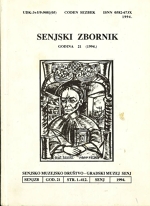TEMELJNA SKICA GEOEKOLOŠKIH OSOBINA VELEBITA
SKETCH OF THE FUNDAMENTAL GEOECOLOGICAL CHARACTERISTICS OF THE VELEBIT MOUNTAIN RANGE
Author(s): Andrija BognarSubject(s): Physical Geopgraphy, Regional Geography, Environmental Geography
Published by: Senjsko muzejsko društvo i Gradski muzej Senj
Keywords: the fundamental geoecological characteristics; Velebit mountain;
Summary/Abstract: The Mountain Range of Velebit is a part of the mountain zone of the Outer Dinarides, characterized by the prevailing nonkonformed block-folded structure. On the prevailing carbonate basement (limestones, dolomites) linear and bended chains of ridges have been developed in SE, S and central part of the mountain. Norther part of Velebit has mostly character of the mountain massif with the dominant block-folded structure. Velebit is characterized by the steplike transversal profile. Karst is the predominant relief type. Very high relief dissection rate stimulated intensive slope processes and corresponding relief forms (pediments). At the highest sections of the mountain (higher than 1.350 m) there are remnants of glaciation (exaration morphologic forms as well as the corresponding correlative sediments and moraine forms) and periglacial modelling which took place in the Pleistocene. Periglacial processes are active today only above the altitudes of 1.400-1.500 m. The Velebit Mountain represents an important climatic barrier towards the continental part of Croatia. There are climatic differences between the coastal part of the mountain and it's NE slope in Lika. The annual rainfall is around 1.000 mm in the coastal part, while in the higher part of the mountain it exceeds to 3.000 mm. The situation is similar with the temperature contrasts; while on the coast the freezing temperatures are rare, on the higher part of the mountain the winter temperatures sometimes drop below -30°C and -40°C. This results in a number of vegetational peculiarities. It should be noted that vegetation in this region ranges from subtropical laurel forests in the southern part of the coastal zone to spruce forests of the taige type in the higher zone of Velebit. The intensive human influence on the natural vegetation cover of the karst has been present for centuries. It is almost a rule that severe degradation of the vegetation cover is accompanied by degradation and destruction of soil by erosion and deflation. On the limestones and dolomite rocks on the lower hypsometric levels up to approximately 700 m, calcic cambiosol prevails, while on the higher locations orthic rendzina on hard limestone is predominant. On deeper and loose moraine and fluvioglacial materials, orthic rendzina is found.
Journal: Senjski zbornik - prilozi za geografiju, etnologiju, gospodarstvo, povijest i kulturu
- Issue Year: 21/1994
- Issue No: 1
- Page Range: 1-8
- Page Count: 8
- Language: English, Croatian

